Remember a few posts back when I showed you a cute, tiny owl? I said I could have taken it home in my pocket, and estimated that it was smaller in size than my head.
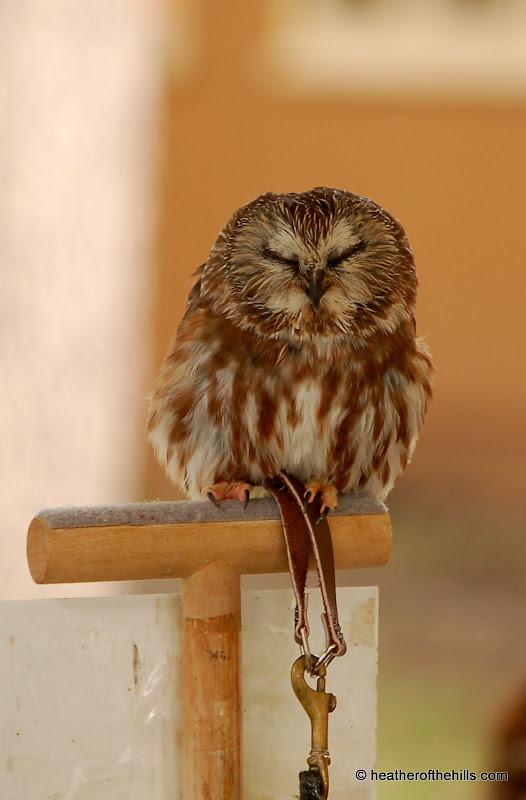
A captive Northern Saw-whet Owl who is part of the educational display for the Back to the Wild wildlife rehabilitation center.
This past Friday, I finally got a chance to meet one of these little cuties up close. But let's back up a little bit.
I had never even heard of Saw-whet Owls until last spring. It was at the ODNR's annual Wildlife Diversity conference that I heard a presentation about Saw-whet Owls given by Kelly Williams-Sieg, an Ohio University grad student and licensed bird bander. The presentation detailed her work with Project Owlnet and how she's been banding and researching Saw-whets (and other birds) since 2004 at Earl H. Barnhart Buzzards Roost Nature Preserve in Chillicothe, Ohio. As her presentation wrapped up, I jotted down some notes and thought, "Wow, wouldn't it be cool to attend one of these banding sessions?" I left it at that, thinking it a purely whimsical notion at the time. Fast forward 6 months or so to an event at Killdeer Plains Wildlife Area, where Ohio Certified Volunteer Naturalists met for a weekend of pure nature bliss, full of learning about and looking at birds, butterflies, flowers and beetles. It was here that I met Bob Scott Placer, a licensed bird bander, who also happens to live practically down the street from me. Bob has been helping Kelly band owls at Buzzards Roost from day one. After some discussions with Bob, I went out to Buzzards Roost once last year to check out the banding operation, but we struck out. It was early December, and they hadn't seen any Saw-whets for a week or so. Bob advised that we come in early November the next year for better luck.
And so we did just that. There was no pressure to see an owl or anything. It just so happened to be my birthday on the day that I chose for our owling adventure.
A group of folks from the
Scioto Valley Bird and Nature Club was already there by the time we arrived around 8:15 pm. Kelly, Bob and Lisa, our banders for the evening, made several checks of the mist nets between 8:30 and 10:15, each time coming up empty-handed. By 10:30 all the bird club folks had headed home, so Dave and I were the only onlookers left. Around 10:45 the nets were checked, and still there was nothing. Bob said that during previous banding sessions so far this season the owls had been showing up pretty late, so we all hung in there for one more net check at 11:15. Lo and behold, Kelly checked a net and said she had an owl. I let out a small squeal of delight and rushed down to see for myself. Kelly deftly but gently untangled the owl from the net. It clacked its beak several times, a sound of warning. We heard plenty more of that as our time with the owl went on.
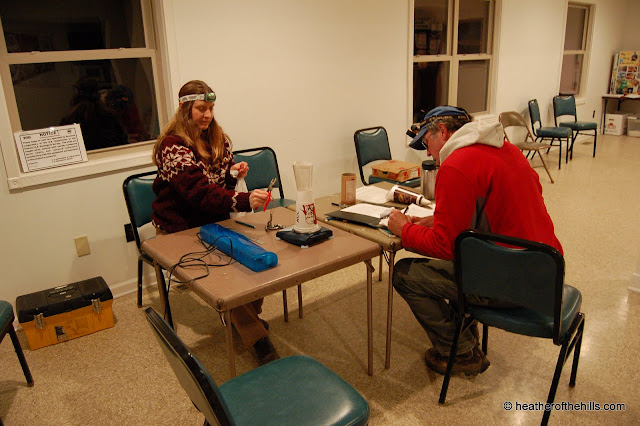
Kelly Williams-Sieg and Bob Scott Placier prepare to collect data from a Northern Saw-whet Owl.
Once the owl was freed from the mist netting, we brought it inside to band it and collect various data, such as wing and tail length, weight, and amount of fat observed.
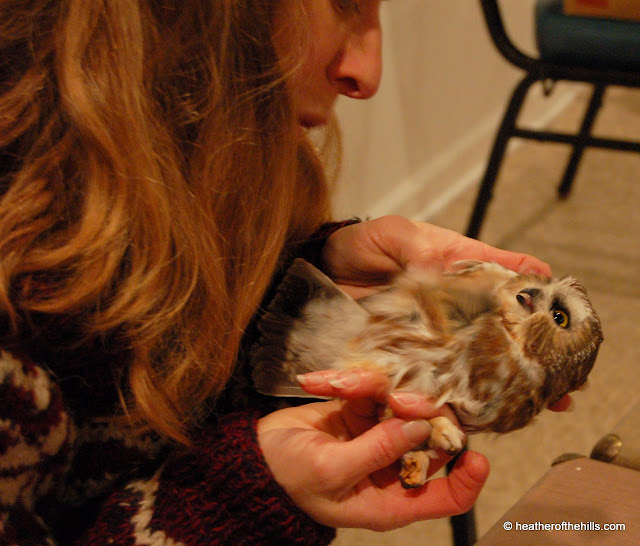
Kelly blows the owl's feathers out of the way so she can look for fat deposits under its skin. This bird showed no fat deposits, which is typical of a bird that is in the middle of migration. Kelly also showed me how she feels along either side of the breast bone for fat, and let me feel for myself.
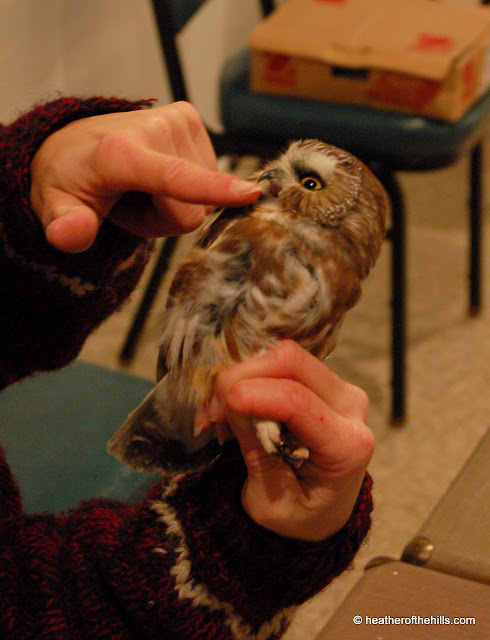
Kelly demonstrates how a Saw-whet bite doesn't hurt. That hooked beak looks intimidating, but that's mainly a tool for ripping the flesh of its prey. The real danger on this little predator is its talons, which Kelly experienced first-hand several times over the course of several minutes.
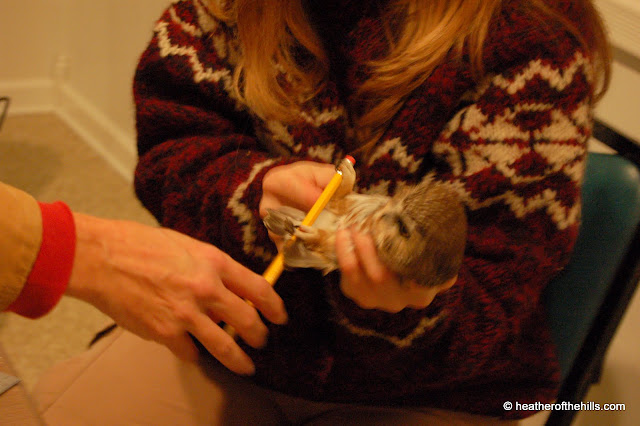
Normally docile and seemingly tame in the hand, this Saw-whet was an exception to the rule. She was feisty right from the start, complete with lots of bill snapping and much kicking and grabbing with those talons. Here Lisa gives the owl a momentary distraction of a pencil to hang on to while Kelly tries to reposition her for more data collection.
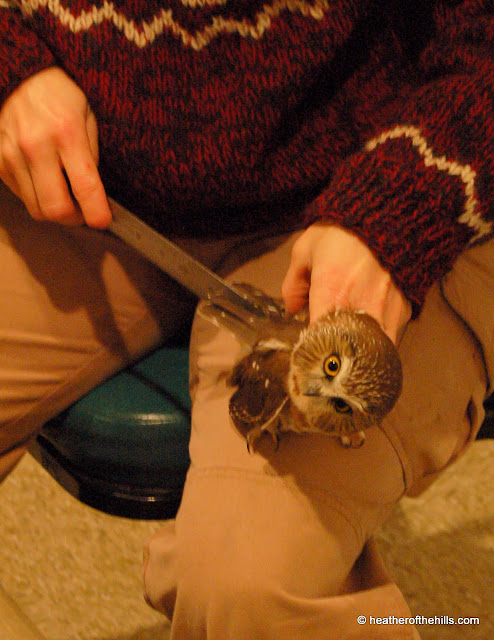
Taking the tail measurement. I think the owl has a most displeased expression here.

For those of you wondering how you weigh an owl (or any other small bird), this is how it's done. They go head-first into some kind of tube, which keeps them from wiggling around too much. This Saw-whet weighed in at 98.2 grams, which Kelly said was on the high side for this species. The weight, combined with tail and wing measurements suggests that this owl is a female (typically, female owls are larger than the males).
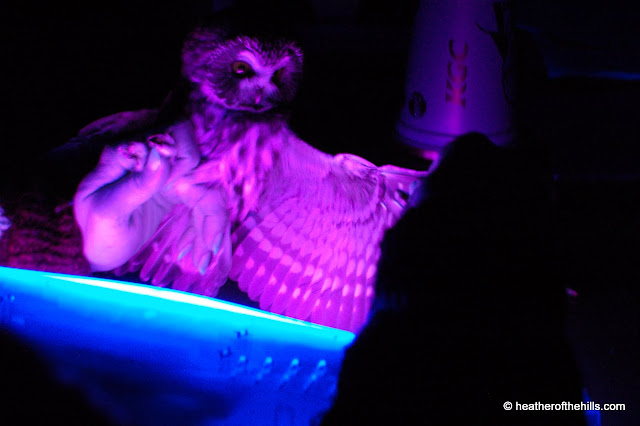
A black light is used to help age the bird. There is a certain pigment in the owls flight feathers that show up in varying degrees of pink, depending on its age. This photo doesn't do the test justice because the whole bird shows up as pink, which is not what we really saw. Based on the amount of pink we saw, and how bright the pink was, Kelly determined that this owl was born this year. That's called a hatch-year bird. So we had ourselves a fiesty, hatch-year female.

Now that we've got her vitals, let enjoy her cuteness, shall we?
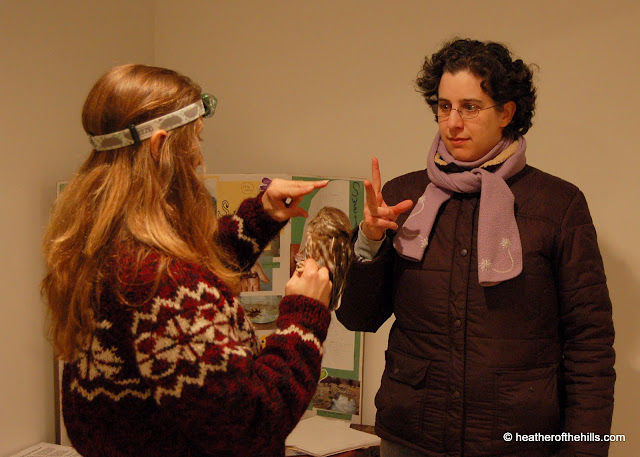
Rock, paper, scissors, owl! Just kidding. Kelly's showing me how to hold my fingers as I prepare to get the best birthday present a birder could ask for...

... A loving gaze from a teeny, tiny owl. Say it with me everyone: Awwwwwwwwww.

Despite all the attitude and the feistyness, this little ball of fluff could not resist the power of a good head rub. I have read about this phenomenon from others, and she did indeed just keep pushing her head back farther and farther as I ran my finger down her head and back. She did show some signs of resistance though, as she simultaneously pushed into the head rub while snapping her bill half-heartedly. The theory behind what seems to be the owl's enjoyment of this action is that it reminds them of mutual grooming and preening that they do in the wild (especially mother with owlet).

One last pose with "my" owl before we took her outside to be released.
It took a few minutes for us to walk down to the spot where we released her, which gave her eyes time to adjust to the dark enough so that she could see to fly off to a nearby perch. Kelly placed her on my arm, and I had a feeling it wouldn't take her too long to fly off, given all the attitude she had given us while in our care. Sure enough, she took off within 5 seconds, wooshing over my head into a tree just behind me. Luckily I was able to turn around fast enough to see her outstretched wings back-lit against a sky brightened by a waning moon just before she landed.
All in all, I'd say that experience was a pretty cool birthday present. Thank you Kelly, Bob and Lisa. And thank you, little owl. I was very honored to meet you.
But wait, don't go away yet! Please be sure to check out
THIS ARTICLE from the October 2008 issue of Ohio Magazine that goes into a little more detail about the Saw-whet banding project. And to see the banding process in action, watch
THIS VIDEO by ODNR's Division of Wildlife.
